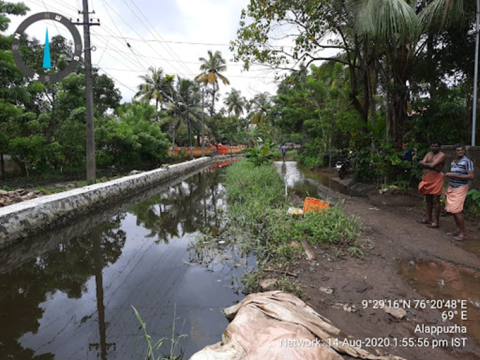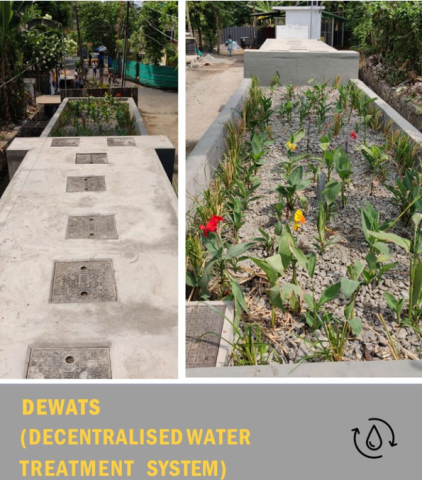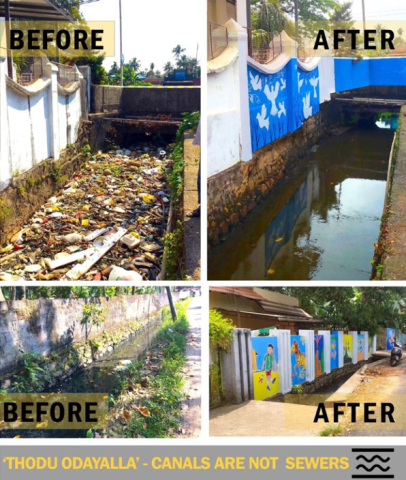Revitalising Alappuzha's canals with community collaboration: A case study of urban transformation in Kerala, India
Revitalising Alappuzha's canals with community collaboration: A case study of urban transformation in Kerala, India
For World Water Day 2024, Damini Rathore of ICLEI South Asia analyses the roles of appropriate technology, capacity development and community engagement in a case study of urban transformation in Alappuzha, Kerala.
Alappuzha, in the Indian state of Kerala, is well known for its picturesque canals, lagoons and backwaters. However, even this verdant area has not remained untouched by environmental degradation, with vulnerable communities bearing the brunt.
Municipal Colony in Chathanad, Alappuzha, is a community of former sanitation workers who were involved in "manual scavenging" (human waste collection). In the past, these marginalised people suffered harsh living conditions, inadequate sanitation services, uncontrolled water pollution, and recurrent waterlogging. Even after the practice of manual scavenging was ended, there was little change in their living conditions.
In May 2018, a study of the water and sanitation issues in the area found that pollution from waste in the sub-canals was harming the health of the canal system. The study was part of a summer-school model canal-restoration project ‘Canalpy’, involving 300 students from different disciplines from across India and with Cochin University College of Engineering, Kuttanadu (CUCEK) as the main academic partner. It was funded by the Kerala Institute of Local Administration (KILA), and supported by the Indian Institute of Technology Bombay (IIT-B), the National Environmental Engineering Research Institute (NEERI), Consortium for DEWATS Dissemination (CDD) Society, Inspiration and CUCEK for developing a holistic and scientific solution for managing canal pollution.

Going local
The idea was to look at the root causes of canal pollution to improve the sanitation system in human settlements along the canals. Operating under the overarching principles of climate resilience and adaptation, the initiative embraced subsidiarity to seek management of issues at the lowest possible level. This meant opting for localised non-invasive technology such as phytoremediation to minimise the impacts on the environment, advocating for participatory planning to ensure community ownership and resilience, and capacitating local governance structures to drive sustainable change.
The study involved a survey of the canals, feedback from various stakeholders, and looking at the willingness of people to pay for better sanitation services. The initiative went beyond mere sanitation infrastructure development, and recognised the nexus between environmental degradation, public health, adaptation and social equity. By addressing the root causes of water pollution and inadequate sanitation, the initiative sought to support the Municipal Colony and its environs against the escalating impacts of climate change, which disproportionately affect marginalised communities.
Three key organisations, that led the initiative, brought their expertise to address the prevailing sanitation and water pollution challenges.
- CDD Society introduced the DEWATS (Decentralised Wastewater Treatment System), which involved connecting household toilets to a sewer network and treating the collected sewage through phytoremediation before discharging it into the canal. They helped in strengthening the existing solid waste management system by constructing aerobic bins for processing organic/food waste. They also conducted training and capacity-building programmes for stakeholders from the Alappuzha Municipal Council, the community and sanitation workers, and provided support for the operation and maintenance of the newly installed infrastructure.
- KILA played a pivotal role in engaging the community, fostering ownership over the sanitation facilities and ensuring overall project coordination. They conducted awareness programmes, meetings, and workshops, sensitising and empowering residents to participate effectively in the programme. They also provided essential training to the identified community members for sustainable management of the new infrastructure.
- IIT Bombay was responsible for technical design, analysis, and research to gather data on sanitation practices and water quality. They recommended appropriate technologies, conducted training programmes, and ensured the technical soundness of the DEWATS system. They engaged the community proactively through data collection and research, and helped residents to understand sanitation practices and water quality issues. They sought community feedback and ensured that those perspectives were integrated into the project design and implementation.
The canal rejuvenation project prioritised community involvement as a core aspect of its strategy, and recognised the essential role of canals in daily life. The project aimed to foster community ownership and pride by highlighting canals' significance and advocating for their preservation. Led by local youth, the 'Thodu Odayalla' awareness campaign played a central role in educating residents. Local canal committees were established, empowering communities to manage their canal segments and safeguard water resources. Through training and resource provision, community representatives were entrusted with overseeing the maintenance of new sanitation systems, and ensuring active participation in the project's long-term sustainability efforts.

Community impact
The project succeeded in the cleaning and desilting of 14 canals, removal of debris, and strategic installation of screens and trash racks to enhance cleanliness and appeal. It identified polluted areas and advocated for decentralised wastewater treatment, resulting in notable water quality improvements. Additionally, 10 kilometers of canal banks were revitalised as green walkways with improved lighting, pavements, waste bins, and vibrant graffiti, creating accessible community spaces. Ultimately, the initiative facilitated the development of a more efficient water transport system, potentially boosting mobility and economic opportunities for 40,000 households and structures. Through community engagement, residents were encouraged to take pride and ownership in preserving the canal network and adhering to waste disposal regulations.
The Municipal Colony project exemplified sustainable urban transformation through technical expertise and community engagement. It demonstrated the suitability of using decentralised nature-based systems for wastewater management in areas lacking conventional technological systems, and the ease with which they can be adapted to varied contexts, such as low-lying regions with high water tables and topographies. The involvement of the community proved to be critical for building ownership of the new systems and ensuring their long-term sustainability. The transformation of canal banks into green walkways with enhanced infrastructure not only improved the cleanliness and aesthetics of the area, but also provided appealing and accessible spaces for the community, potentially improving mobility and economic opportunities.

